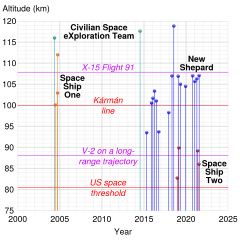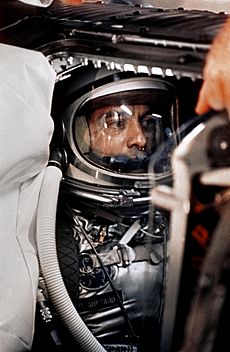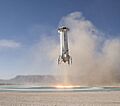New Shepard facts for kids
 |
|
| Manufacturer | Blue Origin |
|---|---|
| Country of origin | United States of America |
| Size | |
| Height | 18m (60ft) |
| Diameter | 3.7m (12.1ft) |
| Mass | |
| Stages | 1 |
| Launch history | |
| Status | Active |
| Launch sites | Launch Site One |
| Total launches | 23 |
| Successes | 22 |
| Failures | 1 |
| Landings | 21 |
| First flight | 29 April 2015 |
| Single stage | |
| Engines | 1 BE-3 |
| Thrust | 110,000 lbf (490 kN) |
| Burn time | 141 seconds |
| Fuel | LH2 / LOX |
The New Shepard is a special kind of reusable rocket built by a company called Blue Origin. It's designed to take people and things on short trips to the edge of space. The rocket is named after Alan Shepard, who was the first American to travel into space.
This rocket can launch straight up and then land straight down again, just like it took off. This is called vertical takeoff and landing. New Shepard can carry up to six people or cargo into space. They go just high enough to experience a few minutes of weightlessness, where they can float around, before coming back to Earth.
The New Shepard has two main parts: a booster rocket and a crew capsule. The capsule is where the passengers sit. The booster rocket uses a powerful BE-3PM engine to push the capsule above the Kármán line. This line is like an invisible boundary that many people consider the start of space.
After the trip, the capsule returns to Earth using three parachutes and a small rocket motor for a soft landing. The booster rocket lands vertically back on the same launchpad it started from. Blue Origin has launched and landed the New Shepard 22 times successfully, with one partial success and one failure. The rocket is about 15 meters (49 feet) tall and 3.7 meters (12 feet) wide.
Contents
Journey to Space: How New Shepard Began

The journey to create New Shepard started a long time ago. In 2006, Blue Origin built a smaller test rocket called Goddard. This rocket made its first flight on November 13, 2006, and it was a success! Goddard was built in Kent, Washington, in the United States.
Blue Origin also worked on developing the BE-1 rocket engine, which was used in the Goddard test vehicle. To carry people, they also needed a space capsule. In 2012, they tested a full-size crew capsule. During this test, the capsule fired its emergency escape motor and launched away from a fake rocket. It went up about 700 meters (2,300 feet) and then landed safely with parachutes.
In 2015, Blue Origin announced that their main engine, the BE-3PM, was ready. They planned to start flying the New Shepard rocket later that year. The first full-scale New Shepard rocket was built, but it crashed during its first test flight in April 2015. However, the capsule landed safely.
By 2016, Blue Origin had built three New Shepard vehicles. The team even won the Collier Trophy, a big award, for showing that rocket boosters could be reused.
First Crewed Flights and Milestones
On July 20, 2021, New Shepard made history with its first flight carrying people into space. This flight lasted about 10 minutes and crossed the Kármán line. The passengers included Jeff Bezos (who founded Blue Origin), his brother Mark Bezos, Wally Funk, and Oliver Daemen.
New Shepard then flew six more times with crews between July 2021 and August 2022. These flights carried famous people like Wally Funk (who became the oldest person to fly to space at 82) and actor William Shatner. Many paying customers also flew. By June 2022, ticket sales for New Shepard had earned $50 million.
In September 2022, an uncrewed mission (meaning no people were on board) had a problem. The main engine failed, but the emergency escape system worked perfectly. The capsule landed safely, but the booster rocket was lost. After an investigation, Blue Origin found that a part of the engine nozzle failed. They plan to resume flights soon.
Different Versions of New Shepard Rockets
Blue Origin has built several versions of the New Shepard rocket, each with improvements.
New Shepard 1: The First Full-Scale Rocket
The very first full-size New Shepard rocket was called NS1. It flew on April 29, 2015, reaching an altitude of about 93.5 kilometers (58 miles). The test flight was mostly a success because the capsule, named RSS Jules Verne, landed safely with parachutes. However, the booster rocket crashed during its landing attempt due to a problem with its control system.
New Shepard 2: The Reusable Pioneer
New Shepard 2 (NS2) was the second rocket. It was a true pioneer because it made five successful flights and landings in 2015 and 2016. This rocket showed that a booster could be reused multiple times, which is a big step for space travel. After its fifth flight in October 2016, NS2 was retired.
New Shepard 3: For Cargo and Testing
New Shepard 3 (NS3), also known as "Tail 3," flies with a capsule called RSS H. G. Wells. This version was made to be even more reusable and have better heat protection. It also has new panels that make it easier to fix and maintain. NS3 started its test flights in 2017.
This rocket is used to carry cargo and conduct experiments. It will not carry human passengers. Its first flight on December 12, 2017, was special because it was the first time New Shepard flew under a full launch license from the US Federal Aviation Administration (FAA). This meant Blue Origin could now get paid to carry things into space. On that flight, it carried 12 experiments and a test dummy named "Mannequin Skywalker."
NS3 has also been used to test new technologies for NASA, like SPLICE, which helps with lunar (Moon) landings. Sadly, the New Shepard 3 booster was destroyed during the NS-23 mission on September 12, 2022. Its engine failed, but the capsule and its experiments landed safely.
New Shepard 4: Carrying Humans to Space
New Shepard 4 (NS4), or "Tail 4," is the rocket that carries human passengers. Its capsule is called RSS First Step. This rocket was built in 2018.
Its first flight without people was on January 14, 2021. Then, on July 20, 2021, NS4 made history by carrying its first human passengers, including Jeff Bezos. Since then, NS4 has completed several more crewed flights, taking many people to the edge of space. On December 11, 2021, the Blue Origin NS-19 flight carried six passengers, which is the full number the capsule is designed for.
Who Has Flown on New Shepard?
Blue Origin started flying passengers on July 20, 2021, with the 16th flight of New Shepard (NS-16).
- The first passengers on NS-16 were Jeff Bezos, Mark Bezos, Wally Funk, and Oliver Daemen. At 82, Wally Funk was the oldest person to go to space at that time, and Oliver Daemen, at 18, was the youngest.
- The second crewed flight on October 13, 2021, included actor William Shatner, famous for playing Captain Kirk in Star Trek!
- On December 11, 2021, the third crewed flight, Blue Origin NS-19, carried NFL legend Michael Strahan and Laura Shepard Churchley, who is Alan Shepard's daughter.
- The fourth crewed flight on March 31, 2022, was the first with no celebrity passengers.
- The fifth crewed flight on June 4, 2022, included educational YouTuber Katya Echazarreta.
- The sixth crewed flight on August 4, 2022, had Coby Cotton, one of the founders of the popular YouTube channel Dude Perfect. This flight also carried the first space travelers from Egypt and Portugal.
By June 2022, Blue Origin had made over $100 million from its space tourism program with New Shepard.
New Shepard Flight Records
Here's a list of the New Shepard flights:
| Launch No. | Date | Vehicle | Highest Point | Result | Notes |
|---|---|---|---|---|---|
| 0 | 19 October 2012 |
|
0.7 km (0.4369 mi) | Success | Test of the crew capsule's emergency escape system. |
| 1 | 29 April 2015 |
|
93.5 km (58.1 mi) | Partial success | Flew to 93.5 km. Capsule recovered, but booster crashed on landing. Still considered a success for the capsule. |
| 2 | 23 November 2015 |
|
329,839 ft (100.535 km; 62.4695 mi) | Success | First sub-orbital spaceflight and landing of the NS2 booster. |
| 3 | 22 January 2016 |
|
333,582 ft (101.676 km; 63.1784 mi) | Success | Successful flight and landing of a booster that had flown before. |
| 4 | 2 April 2016 |
|
339,178 ft (103.381 km; 64.2383 mi) | Success | Another successful flight and landing of a reused booster. |
| 5 | 19 June 2016 |
|
331,501 ft (101.042 km; 62.7843 mi) | Success | The fourth successful launch and landing of the same rocket. |
| 6 | 5 October 2016 |
|
|
Success | Successful test of the emergency escape system during flight. This was the fifth and final flight for NS2. |
| 7 | 12 December 2017 |
|
|
Success | First flight of the NS3 rocket and the new Crew Capsule 2.0. |
| 8 | 29 April 2018 |
|
351,000 ft (107 km; 66.5 mi) | Success | Successful flight and landing of the reused NS3 booster. |
| 9 | 18 July 2018 |
|
389,846 ft (118.825 km; 73.8345 mi) | Success | Tested the in-flight abort system at a high altitude. Carried a test dummy. |
| 10 | 23 January 2019 |
|
c. 106.9 km (66.4 mi) | Success | Carried eight NASA research experiments. |
| 11 | 2 May 2019 |
|
c. 346,000 ft (105 km; 65.5 mi) | Success | Carried 38 microgravity research payloads. |
| 12 | 11 December 2019 |
|
c. 104.5 km (64.9 mi) | Success | Carried various commercial and research payloads. Sixth launch and landing for this rocket. |
| 13 | 13 October 2020, 13:37 |
|
c. 351,200 ft (107.0 km; 66.52 mi) | Success | Seventh flight of this capsule/booster. Tested lunar landing technologies for the Artemis program. |
| 14 | 14 January 2021, 16:57 |
|
|
Success | First flight for the NS4 rocket and capsule, without a crew. |
| 15 | 14 April 2021 16:51 |
|
|
Success | Second flight of NS4. Blue Origin staff practiced the astronaut boarding process. |
| 16 | 20 July 2021 13:12 |
|
|
Success | First flight with human passengers: Jeff Bezos, Mark Bezos, Wally Funk, and Oliver Daemen. |
| 17 | 25 August 2021 14:31 |
|
|
Success | Carried 18 commercial payloads and a NASA lunar landing test. |
| 18 | 13 October 2021 14:49 |
|
|
Success | Second crewed flight. Passengers included actor William Shatner. |
| 19 | 11 December 2021 |
|
Success | Third crewed flight. Passengers included Michael Strahan and Laura Shepard Churchley. | |
| 20 | 31 March 2022 13:57 |
|
|
Success | Fourth crewed flight. All six passengers were paying customers. |
| 21 | 4 June 2022 13:25 |
|
|
Success | Fifth crewed flight. Passengers included educational YouTuber Katya Echazarreta. |
| 22 | 4 August 2022 13:56 |
|
|
Success | Sixth crewed flight. Passengers included Coby Cotton. |
| 23 | 12 September 2022 14:27 |
|
37,401 ft (11.400 km; 7.0835 mi) | Failure | Uncrewed research mission. Booster engine failed, but the capsule safely ejected and landed. The booster was lost. |
How New Shepard is Built
The New Shepard is designed to be fully reusable. It takes off and lands vertically. It has two main parts: a pressurized crew capsule and a propulsion module (the booster). The entire flight is controlled by computers on board; there's no human pilot or control from the ground.
The Crew Capsule: Your Ride to Space
The New Shepard crew capsule is where up to six people can sit. It has a special launch escape system that can quickly separate the capsule from the booster rocket if there's an emergency during launch. This system uses a powerful rocket motor.
After separating from the booster, the capsule deploys three parachutes. It then uses a small solid rocket motor just before landing to slow down even more, ensuring a soft landing for the passengers, at about 24 km/h (15 mph). The inside of the capsule is about 15 cubic meters (530 cubic feet) in size.
How a New Shepard Flight Works
New Shepard rockets launch from a place called Launch Site One (LS1), which is about 30 miles north of Van Horn, Texas.
The rocket flies for about 110 seconds, reaching an altitude of about 40 kilometers (25 miles). After that, the capsule continues to climb higher due to its speed, going above the Kármán Line (the edge of space).
Once it reaches its highest point, the vehicle starts to fall back down. The booster rocket restarts its engines a few seconds before landing vertically, very close to where it launched. The total flight time for the rocket is usually over 7 minutes.
For flights with people, the crew capsule separates from the booster near the highest point. The booster lands on its own, while the crew capsule floats down under three parachutes. The entire trip for passengers lasts about 10 minutes. If there's any problem with the rocket, the crew capsule can use its emergency boosters to quickly fly away and then land safely with parachutes.
New Shepard's Role in Space Research

New Shepard is not just for space tourism; it's also a great tool for science! Blue Origin offers flights for experiments that need to go above 100 kilometers (62 miles). These experiments can be inside the capsule or attached to the outside of the rocket.
Scientists can get several minutes of microgravity (where things float) or partial gravity for their research. The gentle return of the payloads makes New Shepard perfect for delicate experiments.
Since 2011, Blue Origin has offered New Shepard for NASA's Flight Opportunities Program. This program helps test new space technologies. New Shepard can carry research payloads weighing about 11.3 kilograms (25 pounds) on its 10-minute flights.
In 2018, New Shepard carried a device called the Schmitt Space Communicator SC-1x. This device created the first commercial Wi-Fi hotspot in space and even sent the first commercial Twitter message from space! NASA helped fund this project.
On September 12, 2022, 18 NASA experiments were on board NS-23 when the booster engine failed. Even though the booster was lost, the emergency system worked, and the capsule with all the experiments landed safely.
Images for kids
-
Alan Shepard, the first American in space and New Shepard's namesake, in the Freedom 7 capsule before his May 5, 1961, launch
See also
 In Spanish: New Shepard para niños
In Spanish: New Shepard para niños








